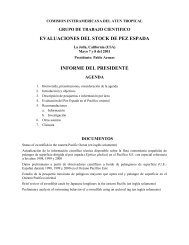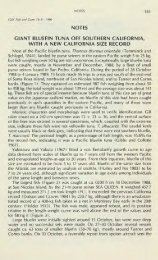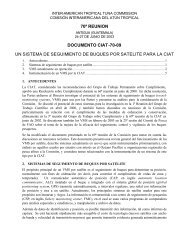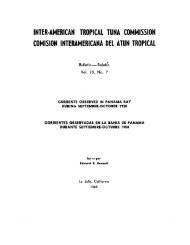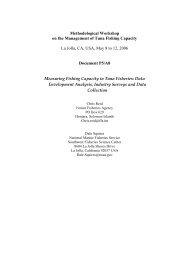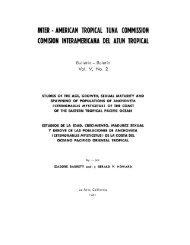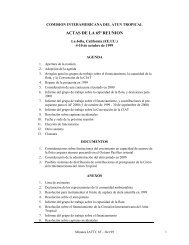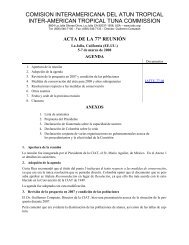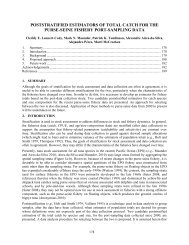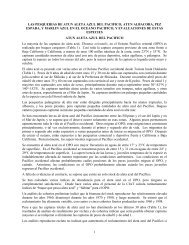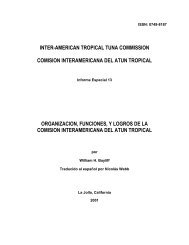INTER-AMERICAN TROPICAL TUNA COMMISSION - Comisión ...
INTER-AMERICAN TROPICAL TUNA COMMISSION - Comisión ...
INTER-AMERICAN TROPICAL TUNA COMMISSION - Comisión ...
- No tags were found...
Create successful ePaper yourself
Turn your PDF publications into a flip-book with our unique Google optimized e-Paper software.
115Species and stockIncidental mortalityNumber Metric tonsOffshore spotted dolphinNortheastern 179 12Western-southern 165 11Spinner dolphinEastern 349 15Whitebelly 170 10Common dolphinNorthern 107 8Central 14 1Southern 138 10Other dolphins 9 49 3Total 1,171 70Studies of the association of tunas with dolphins have been an important component of the staff’s long-term approach to understandingkey interactions in the ecosystem. The extent to which yellowfin tuna and dolphins compete for resources, or whether either orboth of them benefits from the interaction, remain critical pieces of information, given the large biomasses of both groups and theirhigh rates of prey consumption. Diet and stable isotope analyses of yellowfin tuna and spotted and spinner dolphins caught in multispeciesaggregations by purse-seine vessels in the EPO demonstrate significant differences in food habits and trophic position ofthe three species, suggesting that the tuna-dolphin association is probably not maintained by feeding advantages. This conclusion issupported by radio tracking studies of spotted dolphins outfitted with time-depth recorders, which indicate that the dolphins feedprimarily at night on organisms associated with the deep scattering layer, while food habits studies of yellowfin tuna show primarilydaytime feeding.During August-December 2006, scientists of the U.S. National Marine Fisheries Service (NMFS) conducted the latest in a series ofresearch cruises under the Stenella Abundance Research (STAR) project. The primary objective of the multi-year study is to investigatetrends in population size of the dolphins that have been taken as incidental catch by the purse-seine fishery in the EPO. Data oncetacean distribution, herd size, and herd composition were collected from the large-scale line-transect surveys to estimate dolphinabundance. The 2006 survey covered the same areas and used the same methods as past surveys. Data from the 2006 survey producednew abundance estimates, and previous data were re-analyzed to produce revised estimates for 10 dolphin species and/orstocks in the EPO between 1986 and 2006. The 2006 estimates for northeastern offshore spotted dolphins were somewhat greater,and for eastern spinner dolphins substantially greater, than the estimates for 1998-2000. Estimates of population growth for thesetwo depleted stocks and the depleted coastal spotted dolphin stock may indicate they are recovering, but the western-southern offshorespotted dolphin stock may be declining. The abundance estimates for coastal spotted, whitebelly spinner, and rough-toothed(Steno bredanensis) dolphins showed an increasing trend, while those for the striped (S. coeruleoalba), short-beaked common (Delphinusdelphis), bottlenose (Tursiops truncatus), and Risso’s (Grampus griseus) dolphins were generally similar to previous estimatesobtained with the same methods.Scientists of the NMFS have made estimates of the abundances of several other species of marine mammals based on data fromresearch cruises made between 1986 and 2000 in the EPO. The STAR 2003 and 2006 cruises will provide further estimates of abundanceof these mammals. Of the species not significantly affected by the tuna fishery, short-finned pilot whales (Globicephalamacrorhynchus) and three stocks of common dolphins showed increasing trends in abundance during that 15-year period. The apparentincreased abundance of these mammals may have caused a decrease in the carrying capacity of the EPO for other predatorsthat overlap in diet, including spotted dolphins. Bryde’s whales (Balaenoptera edeni) also increased in estimated abundance, butthere is very little diet overlap between these baleen whales and the upper-level predators impacted by the fisheries. Striped dolphins(Stenella coeruleoalba) showed no clear trend in estimated abundance over time, and the estimates of abundance of sperm whales(Physeter macrocephalus) have tended to decrease in recent years.9 “Other dolphins” includes the following species and stocks, whose observed mortalities were as follows: Central American spinner dolphins(Stenella longirostris centroamericana) 9 (0.4 t); striped dolphins 24 (1.6 t); coastal spotted dolphins 4 (0.3 t); bottlenose dolphins 4 (0.4 t),unidentified dolphins 8 (0.4 t).



